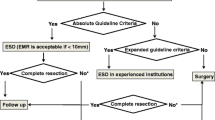Conclusion
The risk of lymph node metastasis has to be smaller than the risk of a surgical procedure to perform local endoscopic resection of curative intention. Depending on the site within the gastrointestinal tract low and high risk groups can be identified. Criteria differ somewhat with the location. For histological work up enbloc resections are the most preferable specimen since the status of resection could be demonstrated histologically. The method of endoscopic resection for early neoplasms is widespread in the colon but is limited to centres in the oesophagus and partially in the stomach. Because of possible complications it is good to have a surgeon close by and for diagnostic purposes a close communication with your pathologist.
Similar content being viewed by others
References
SOETIKNO RM, GOTODA T, NAKANISHI Y et al. Endoscopic mucosal resection. Gastrointest Endosc 2003; 57: 567–79.
SOEHENDRA N, BINMOELLER KF, BOHNACKER S et al. Endoscopic snare mucosectomy in the oesophagus without any additional equipment: a simple technique for resection of flat early cancer. Endoscopy 1997; 29: 380–3.
INOUE H. Endoscopic mucosal resection for the entire gastrointestinal mucosal lesions. Gastrointest Endosc Clin N America 2001; 11: 459–78.
ONO H, KONDO H, GOTODA T et al. Endoscopic mucosal resection for treatment of early gastric cancer. Gut 2001; 48: 225–29.
ELL C, MAY A, GOSSNER L et al. Endoscopic mucosection of early cancer and high-grade dysplasia in Barrett’s oesophagus. Gastroenterology 2000; 118: 670–7.
TANABE S, KOIZUMI W, MITOMI H et al. Clinical outcome of endoscopic aspiration mucosectomy for early stage gastric cancer. Gastrointest Endosc 2002; 56: 708–13.
YAMAMOTO H, YUBE T, ISODA et al. A novel method of endoscopic mucosal resection using sodium hyaluronate. Gastrointest Endosc 1999; 50: 251–6.
MIYAMOTO S, MUTO M, HAMAMOTO Y et al. A new technique for endoscopic mucosal resection with an insulated tip electrosurgical knife improves the completeness of resection of intramucosal gastric neoplasms. Gastrointest Endosc 2002; 55: 576–81.
MIYASHITA M, TAJIRI T, MARUYAMA H et al. Endoscopic mucosal resection scissors for the treatment of early gastric cancer. Endoscopy 2003; 35: 611–12.
VIETH M, ELL C, GOSSNER L et al. Histological analysis of endoscopic resection specimens and early neoplasia. Endoscopy 2004; 36: 776–81.
KASHIMURA H, WATANABE H, YOICHI Ajioka Y, NISHIKURA K, IIRI T, ASAKURA H. The risk factors for nodal micrometastasis of submucosal invasive gastric carcinoma with special reference to assessment of the indication for endoscopic treatment. Gastric Cancer 1999; 2: 33–9.
YOKOYAMA J, AJIOKA Y,Watababe H, ASAKURA H. Lymph node metastasis and micrometastasis of submucosal invasive colorectal carcinoma: an indicator of the curative potential of endoscopic treatment. Acta Medica Biologica 2002; 50: 1–8.
WATANABE H, KOMUKAI S, AJIOKA Y, NISHIKURA K, HASHIDATE H, KIJIMA H. Histopathology of m3 and sm1 invasive squamous cell carcinoma of the esophagus with special reference to endoscopic resection. Stomach and Intestine 1998; 33: 1001–9.
DEINLEIN P, REULBACH U, STOLTE M, VIETH M. Risk factors for lymphatic metastasis from pT1 colorectal adenocarcinoma. Pathologie 2003; 24: 387–93.
VIETH M, STOLTE M. The distinction of high grade dysplasia and invasive carcinoma In: Diversity of gastric carcinoma. Kaminishi, Takubo et al (eds) Springer Verlag Tokyo 2005.
Vieth M, Stolte M. Pathology of early upper GI cancers. Best Pract Res Clin Gastroenterol 2005 (in press).
WESTERTERP M, KOPPERT LB, BUSKENS CJ, TILANUS HW, ten KATE FJW, BERGMANN JHGM, SIERSMA PD, van DEKKEN H, van LANSCHOT JJB. Outcome of surgical treatment of early adenocarcinoma of the esopahgus or gastro-esophageal junction. Virchows Arch 2005; 446: 497–504.
Author information
Authors and Affiliations
About this article
Cite this article
Schumacher, B., Vieth, M. How can the pathological examination of a mucosectomy specimen be improved?. Acta Endosc 35, 730–732 (2005). https://doi.org/10.1007/BF03003332
Issue Date:
DOI: https://doi.org/10.1007/BF03003332




